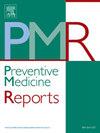Association of Hemoglobin, albumin, lymphocyte, and platelet scores with the risk of overactive bladder syndrome in U.S. adults: A Nationwide cross-sectional study
IF 2.4
3区 医学
Q2 PUBLIC, ENVIRONMENTAL & OCCUPATIONAL HEALTH
引用次数: 0
Abstract
Objective
The pathogenesis of overactive bladder (OAB) is associated with inflammation, yet specific indicators remain unclear. This study aimed to evaluate the association between the hemoglobin, albumin, lymphocyte, and platelet (HALP) score—a composite marker of inflammation and nutritional status—and the risk of OAB in a nationally representative adult population in the United States.
Method
We analyzed data from 24,939 participants in the U.S. National Health and Nutrition Examination Survey (NHANES) between 2005 and 2016. Participants were categorized into quartiles based on HALP scores. Weighted multivariable logistic regression models were used to examine the association between HALP scores and the risk of OAB, adjusting for relevant covariates. Additionally, smooth curve fitting was performed to assess nonlinear relationships.
Result
After adjusting for confounders, higher HALP scores were significantly associated with a lower risk of OAB (odds ratio [OR] 0.965, 95 % confidence interval [CI]: 0.951–0.980). Participants in the highest HALP quartile had a 20 % lower likelihood of OAB compared to those in the lowest quartile (OR 0.800, 95 % CI: 0.729–0.878). A nonlinear inverse relationship was observed between HALP score and OAB risk.
Conclusion
In this large, population-based study, higher HALP scores were independently associated with a lower risk of OAB among U.S. adults. These findings suggest that the HALP score may serve as a useful marker in the prediction and early identification of individuals at risk for OAB.
美国成人血红蛋白、白蛋白、淋巴细胞和血小板评分与膀胱过度活动综合征风险的关系:一项全国性的横断面研究
目的膀胱过动症(OAB)的发病机制与炎症有关,但具体指标尚不清楚。本研究旨在评估血红蛋白、白蛋白、淋巴细胞和血小板(HALP)评分(炎症和营养状况的复合标志物)与OAB风险之间的关系,该评分在美国具有全国代表性的成年人群中进行。方法:我们分析了2005年至2016年美国国家健康与营养检查调查(NHANES)中24939名参与者的数据。参与者根据HALP分数被分为四分之一。采用加权多变量logistic回归模型检验HALP评分与OAB风险之间的关系,并对相关协变量进行调整。此外,进行平滑曲线拟合以评估非线性关系。结果调整混杂因素后,高HALP评分与低OAB风险显著相关(比值比[OR] 0.965, 95%可信区间[CI] 0.951 ~ 0.980)。与最低四分位数的参与者相比,最高HALP四分位数的参与者患OAB的可能性低20% (OR 0.800, 95% CI: 0.729-0.878)。HALP评分与OAB风险呈非线性负相关。在这项基于人群的大型研究中,在美国成年人中,较高的HALP评分与较低的OAB风险独立相关。这些发现表明,HALP评分可以作为预测和早期识别OAB风险个体的有用标记。
本文章由计算机程序翻译,如有差异,请以英文原文为准。
求助全文
约1分钟内获得全文
求助全文
来源期刊

Preventive Medicine Reports
Medicine-Public Health, Environmental and Occupational Health
CiteScore
3.90
自引率
0.00%
发文量
353
 求助内容:
求助内容: 应助结果提醒方式:
应助结果提醒方式:


